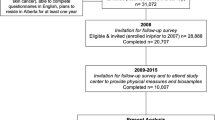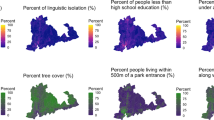Abstract
Objective:
To investigate associations between neighbourhood greenspace and weight status, and to explore the contribution of physical activity to these associations.
Design:
Cross-sectional observational study over two time-periods.
Subjects:
Participants were adults (aged 18 years+) in from a nationally representative sample of the English population for the time periods 2000–2003 (n=42 177) and 2004–2007 (n=36 959).
Measurements:
Weight status was defined as body mass index (BMI) category according to WHO classification. Neighbourhood greenspace was measured using the Generalised Land use Database for England that defines greenspace as parks, open spaces and agricultural land, excluding domestic gardens. Multinomial logistic regression models were used to estimate associations between neighbourhood greenspace and BMI and, in eligible sub-samples, to investigate the contribution of total physical activity to these. All models were adjusted for age, sex, social class, economic activity, neighbourhood income deprivation and urban/rural status.
Results:
In 2000–2003 there was a counterintuitive association between greenspace and BMI. Residence in the greenest areas was significantly associated with increases in overweight (12%) and obesity (23%). In 2004–2007, there was a small protective effect of greenspace for those living in the greenest areas, but this was not statistically significant. Markers of total physical activity did not attenuate associations. Tests for interactions with urban/rural status confirmed that significant associations between neighbourhood greenspace and obesity were only present in urban areas in 2000–2003.
Conclusion:
Better evidence for the utility of greenspace in the prevention of weight gain is required before greenspace interventions are developed.
This is a preview of subscription content, access via your institution
Access options
Subscribe to this journal
Receive 12 print issues and online access
$259.00 per year
only $21.58 per issue
Buy this article
- Purchase on Springer Link
- Instant access to full article PDF
Prices may be subject to local taxes which are calculated during checkout

Similar content being viewed by others
References
Egger G, Swinburn B . An ecological approach to the obesity pandemic. Br med J 1997; 315: 477–480.
Macintyre S, Macdonald L, Ellaway A . Do poorer people have poorer access to local resources and facilities? The distribution of local resources by area deprivation in Glasgow, Scotland. Soc Sci Med 2008; 67: 900–914.
Giles-Corti B, Broomhall MH, Knuiman M, Collins C, Douglas K, Ng K et al. Increasing walking—How important is distance to, attractiveness, and size of public open space? Am J Prev Med 2005; 28: 169–176.
Maas J, Verheij RA, Groenewegen PP, de Vries S, Spreeuwenberg P . Green space, urbanity, and health: how strong is the relation? J Epidemiol Community Health 2006; 60: 587–592.
Maas J, Verheij RA, Spreeuwenberg P, Groenewegen PP . Physical activity as a possible mechanism behind the relationship between green space and health: a multilevel analysis. BMC Public Health 2008; 8: 206.
Kaczynski AT, Henderson KA . Environmental correlates of physical activity: a review of evidence about parks and recreation. Leisure Sci 2007; 29: 315–354.
Kaczynski AT, Potwarka LR, Saelens BE . Association of park size, distance, and features with physical activity in neighborhood parks. Am J Public Health 2008; 98: 1451–1456.
Duncan M, Mummery K . Psychosocial and environmental factors associated with physical activity among city dwellers in regional Queensland. Prev Med 2005; 40: 363–372.
Hillsdon M, Panter J, Foster C, Jones A . The relationship between access and quality of urban green space with population physical activity. Public Health 2006; 120: 1127–1132.
Ellaway A, Macintyre S, Bonnefoy X . Graffiti, greenery, and obesity in adults: secondary analysis of European cross sectional survey. Br Med J 2005; 331: 611–612.
Nielsen TS, Hansen KB . Do green areas affect health? Results from a Danish survey on the use of green areas and health indicators. Health Place 2007; 13: 839–850.
Coombes E, Jones AP, Hillsdon M . The relationship of physical activity and overweight to objectively measured green space accessibility and use. Soc Sci Med 2010; 70: 816–822.
World Health Organization. Obesity: Preventing and Managing the Global Epidemic. Report of a WHO Consultation. Geneva, 2000.
Sproston D, Mindell J . Health Survey for England 2004. The Health of Minority Ethnic Groups. The Information Centre: London, 2006.
Office of the Deputy Prime Minister. Generalised Landuse Database for England 2001. Office of the Deputy Prime Minister: London, 2005.
Department for Communities and Local Government. Generalised Landuse Database Statistics for England 2005. London, 2007.
Noble M, Wright G, Dibben C, Smith GAN, McLennan D, Anttila C et al. Indices of Deprivation 2004. Office of the Deputy Prime Minister, Neighbourhood Renewal Unit: London, 2004.
Noble M, McLennan D, Wilkinson K, Whitworth A, Barnes H, Dibben C . The English Indices of Deprivation 2007. Department for Communities and Local Government: London, 2007.
Countryside Agency. Rural and Urban Area Classification 2004. An Introductory Guide. Countryside Agency: Cheltenham, 2004.
Lachowycz K, Jones A . Greenspace and obesity: a systematic review of the evidence. Obes Rev 2011; 12: 183–189.
Liu GC, Wilson JS, Qi R, Ying J . Green neighborhoods, food retail and childhood overweight: differences by population density. Am J Health Promot 2007; 21: 317–325.
Bell JF, Wilson JS, Liu GC . Neighborhood greenness and 2-year changes in body mass index of children and youth. Am J Prev Med 2008; 35: 547–553.
Levine JA . Non-exercise activity thermogenesis (NEAT). Best Pract Res Cl En 2002; 16: 679–702.
Levine JA, Weg MWV, Hill JO, Klesges RC . Non-exercise activity thermogenesis—the crouching tiger hidden dragon of societal weight gain. Arterioscl Throm Vas 2006; 26: 729–736.
Owen N, Ekelund U, Hamilton M, Gardiner P, Dunstan DW . Sedentary behavior in adults: longitudinal, experimental, and intervention evidence. J Phys Act Health 2010; 7: S334–S336.
Owen N, Mitas J, Sarmiento OL, Reis R, Sugiyama T . Identifying the built environment determinants of physical activity and sedentary behavior: emerging international evidence. J Phys Act Health 2010; 7: S364–S366.
Faculty of Public Health Medicine. Great outdoors: how our natural health service uses greenspace to improve wellbeing: an action report. London, 2010.
Marmot M. . Fair society, healthy lives. Strategic review of health inequalities in England Post 2010. The Marmot Review: London, 2010.
Acknowledgements
This work was supported by the award of a Philip Leverhulme Prize to Professor Steven Cummins. He is also supported by a UK National Institute of Health Research Senior Fellowship. The views expressed in this publication are those of the authors and not necessarily those of the UK National Health Service, the UK National Institute of Health Research or the UK Department of Health.
Author information
Authors and Affiliations
Corresponding author
Ethics declarations
Competing interests
The authors declare no conflict of interest.
Rights and permissions
About this article
Cite this article
Cummins, S., Fagg, J. Does greener mean thinner? Associations between neighbourhood greenspace and weight status among adults in England. Int J Obes 36, 1108–1113 (2012). https://doi.org/10.1038/ijo.2011.195
Received:
Revised:
Accepted:
Published:
Issue Date:
DOI: https://doi.org/10.1038/ijo.2011.195
Keywords
This article is cited by
-
The Differences by Sex and Gender in the Relationship Between Urban Greenness and Cardiometabolic Health: A Systematic Review
Journal of Urban Health (2022)
-
The good, the bad, and the environment: developing an area-based measure of access to health-promoting and health-constraining environments in New Zealand
International Journal of Health Geographics (2021)
-
Characterising urban green space density and footpath-accessibility in models of BMI
BMC Public Health (2020)
-
Demographic Inequities in Health Outcomes and Air Pollution Exposure in the Atlanta Area and its Relationship to Urban Infrastructure
Journal of Urban Health (2019)
-
One size doesn’t fit all: cross-sectional associations between neighborhood walkability, crime and physical activity depends on age and sex of residents
BMC Public Health (2017)



